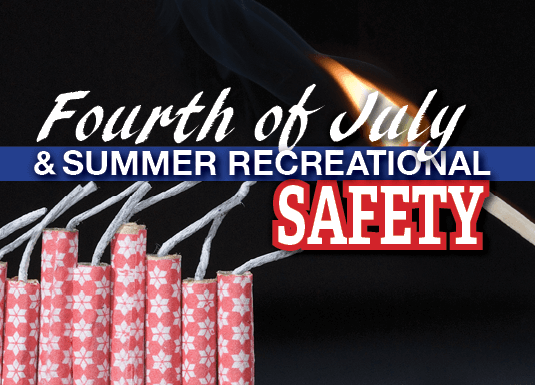
It’s that time of the year again when families and friends gather for barbecues, spending time at the lake, and watching fireworks blaze the sky in honor of Independence Day. Here are some tips and reminders of how to celebrate summer holidays with your family safely.
Firework Safety
According to the United States Consumer Product Safety Commission (2010), on average 230 people go to the emergency room every day with firework-related injuries in the months around the July 4th holiday. The most commonly injured body parts include: the hands and fingers, brain, eyes, head, legs and arms. Here are some helpful tips to help prevent injuries like these:
- Never allow children to play with or to ignite fireworks.
- Always have an adult supervise fireworks activities, even sparklers. The average sparkler burns at a temperature of 2,000 degrees Fahrenheit, which is hot enough to melt some metals.
- Never pick up or re-ignite a firework that did not ignite properly or fully the first time.
- Make sure to have a garden house, blanket or bucket of water on hand in the case of an emergency.
- Remember alcohol, drugs and fireworks are never a good mix.
Water Safety
What’s better than going boating with family and friends on July 4th? Boating and doing other water recreational activities safely. Here are some tips:
- Make sure to always have enough life jackets for those in or on the motorized water vehicle, kayaks, canoes, and tubes.
- Never let your children swim alone.
- Always step in feet first into shallow water, never dive.
- Remember to bring a phone with you should an emergency arise.
- Never operate motorized water recreational vehicles while under the influence of alcohol or drugs.
Sun Safety
Soaking up the sun is a great way to get Vitamin D. Just remember the following tips while doing so:
- Use SPF sunscreen of at least 15 and make sure to reapply throughout the day. Using a higher SPF is recommended, a SPF of 15 provides minimal protection.
- Try to stay out of direct sunlight between the hours of 10am and 4pm.
- Make sure to stay hydrated and watch for signs of heat stroke. Heat stroke signs include: a rapid or a weak pulse, fast and slow breathing, and warm to the touch red skin. To avoid dehydration avoid alcoholic beverages and caffeinated drinks.
Bike and ATV Safety
Riding bikes, motorized vehicles and ATVs are a great way to explore the outdoors. Safety should always be a priority while exploring. The ATV Safety Institute (2016) provides the following helpful golden rules to staying safe:
- Always wear certified or DOT –compliant helmet, goggles, long sleeves, long pants, over-the-ankle boots, and gloves.
- Never ride ATVs on paved roads except to safely cross the road and when permitted by law.
- Never ride under the influence of alcohol or drugs.
- Never carry more passengers than the ATV is designed for.
- Ride an ATV which is correct for your age.
- Supervise riders younger than the age of 16.
- Ride only on designated trails and at a safe speed.
Resources:
- Consumer Product Safety Commission. (2010). Fireworks: Put Safety First This July 4th. Retrieved from http://www.cpsc.gov/
- U.S. Army MWF. (2016). 4th of July Safety Tips. Retrieved from: http://www.armymwr.com/
- ATV Safety Institute. (2016). The ATV Safety Institute’s Golden Rules. Retrieved from: http://www.atvsafety.org/

